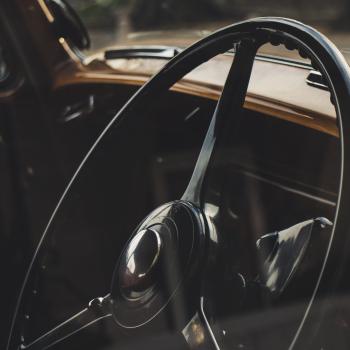Just about every morning for the eight-plus years we’ve lived in our house, the day arrives with the light of sunrise spilling over the head of our bed. And just about every morning, whether scrambling to get the children to school or in my nightgown working, , I’ve marked the time between 6:30 and 7:00 a.m. when a big green pickup truck passed in front of my house, morning sun flashing from the windshield.
“There’s Linda,” my husband would say. “Gone to get cigarettes!”
And yes, that was indeed where she had gone. Before you knew it, she’d be walking down the street with one of the said cigarettes hanging from the corner of her mouth, wearing her ubiquitous Washington Redskins T-shirt and jeans, a plastic liter bottle of Coca-Cola in hand, ready to do good for the world.
Linda, as you’ve doubtlessly now figured out, was our neighbor. She lived in another of the ubiquitous brick 1940s Colonials that line our street, though hers technically belonged to Mary, her longtime partner. The family was Irish-Catholic and large—the kind that filled the neighborhood when Prince George’s County was still mainly white—but siblings had scattered to the winds, the way families now do, and by the time we moved in, it was just Linda and Mary.
Linda and Mary: the relationship for decades unremarkable, part of the donnée. The only hint we saw of anything political was the rainbow-striped kitty-cat bumper sticker on the back of the big green truck, along with one for the local women’s professional soccer team, the Washington Freedom.
From the outset, it was clear that Mary was more feeble, reclusive and perhaps older. She still drove when we first moved in, a glossy red PT Cruiser, but as the years passed—and how quickly, like dust, they seem to have sifted—she withdrew into the house entirely, staying up all night and sleeping all day.
Linda, though, was always in the street. Each year, she decorated their front yard elaborately for Halloween (with hanging bats and spotlights) and Christmas (a shiny, lit-up tree), until some teenage hoodlums vandalized her display and she withdrew, stricken and wounded by the act, tears in her eyes as she told us neighbors.
“How come you think they did that?” she said in her gravelly cigarette voice, suffused in its southern Maryland accent.
She was the master of acts of unasked-for and unexpected grace: Our son was just a wee bairn when we moved in, and one of our first Christmases here, I opened the front door to find Linda wordlessly proffering a giant brownie baked to look like a Christmas tree, branches lovingly adorned with M&Ms ornaments.
Many mornings, not long after the cigarette run, I would see her wheeling a lawn mower and a garbage can of garden tools down the sidewalk to mow and landscape for our neighbor on the other side of us, an African-American single mother who owns an in-home day care center.
Linda reached her apotheosis in my book when, during the epic, fifty-four-inch Snowmageddon of 2010, when for a solid week, my essential-employee husband was holed up in a downtown D.C. hotel, and I was stuck in the house with a preschooler and an infant. (I wrote about it here.) I lifted my head from the pillow one morning and looked out the window to see her slowly, laboriously clearing off my front sidewalk. (And over the years, that happened more than once.)
Linda was an enormously private and unassuming, but she understood that the key to a living community was that we must be part of one another, our boundaries cannot be so distinct and tightly defended. We must of necessity be “into” each other’s business.
Thus, one Sunday afternoon Linda did not immediately call 911 when Mary collapsed onto the bathroom floor, but came to our house in the middle of a Cub Scout meeting and got my husband to help lift her.
After Mary died in late winter 2012, Linda began to turn in on herself. She was in the street less, though her cigarette runs still continued. I passed by her house at night on walks, and saw her face illumined by the blue light of the television, tendrils of smoke dimly curling up.
I invited her to our house for Christmas dinner, for Orthodox Easter, and when she demurred—there was a cousin’s house, or a ready-made dinner from the Giant grocery—I took her a plate of lamb in Saran wrap, or a piece of frosted cake.
“I can’t take this any more,” she complained to my husband on the sidewalk one morning after getting a flat tire from running over the curb. He offered to help her change it: “Come over any time, I’m happy to do it.” But she never asked.
After I saw the second day of newspapers piled up on the porch, and she would neither respond to the door or phone, I screwed up my courage and called the police.
There followed a day such as I don’t wish to experience for the rest of my life, as the street thronged with police cars, ambulances and CSI vans, while I tried to explain to the children what was going on.
It was not a suicide. Rather, her great but saddened heart had simply burst and she, so willing to come to the aid of others, did not want to burden anyone in her last moments. “I think she wanted not to be found,” her sister said to me.
She was a doer of the Word if there ever was one. And while she was dead set against a funeral of any kind, her friends and family will gather soon to remember her. We are all of us part of one another.
The neighbor who runs the daycare asked yesterday if she could borrow my husband’s lawn mower, now that she would have to mow it herself.
He said: “Don’t worry about it. Just let me do it.” And he did.











